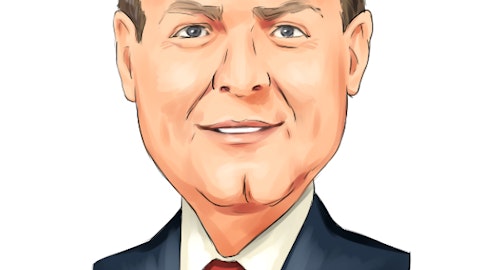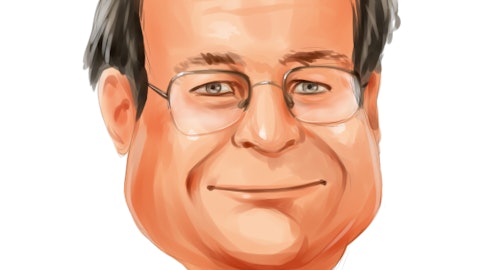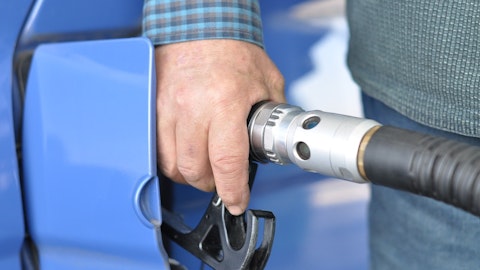Operator: Your next question comes from the line of Anthony Bonadio with Wells Fargo. Your line is open.
Anthony Bonadio: Yeah. Hey. Good morning, guys. Thanks for taking my question. So I want to start with the gallon guidance number suggests flat, I think, to slightly down on per store gallons. I realize you are lapping some potential benefit from elevated prices last summer and we have obviously seen quite a bit of share move around, but within trade down and general consumer softness sort of help you offset that to some extent. So can you just elaborate a little bit more on your assumptions there?
Andrew Clyde: Sure. So you go to the price structure, we don’t expect a big falling price environment that allows us to really differentiate our positioning. I think there is a question around total demand and how much sensitivity we might see. We don’t predict recessions, down trends, et cetera. But recognizing there’s some pressure there. The flip side of that is when there’s pressure there, we gain customers, because more people need affordability and that’s what we deliver. So those are probably a couple of the biggest factors, but the biggest single one is just not expecting that repeat of the price fall off.
Anthony Bonadio: Okay. And then on merchandise margins, that 19.1% you put up in Q4, looks quite a bit below what we have been running at, say, the last five quarters or effectively since you acquired QuickChek, it seems like cost inflation on the food side is playing a part. But can you just dig in a little bit more on what drove that and talk about how you are expecting that to trend as we move into 2023.
Andrew Clyde: Sure. I mean we absolutely saw cost pressure, including outages on ag’s led us some other commodities at QuickChek and that certainly impacted that and the good news is that’s improving. The second thing is we are really establishing QuickChek as the high quality value brand for the products it serves. And so from a price pressure standpoint, we held price longer than the broader market and it showed up in transaction results. I will give you an example. Breakfast represents about 37% of our transactions and in Q4, where we were down 1.7%, the broader QSR industry was down 7.3%. That has paid off, not only in that differential, but January foodservices, transactions at QuickChek are up 6% and that is after making strategic price decisions as well. So we felt the cost pressure, we maintained our price longer in the broader market, it paid off in establishing that brand position that showed up in transactions and that momentum is continuing over into 2023.
Anthony Bonadio: Helpful. Thank, guys.
Andrew Clyde: Thank you.
Operator: Your next question comes from the line of Bobby Griffin with Raymond James. Your line is open.
Bobby Griffin: Good morning, everybody. Thanks for taking my questions and Andrew and the team, congrats on another solid year.
Andrew Clyde: Great. Thanks, Bobby.
Bobby Griffin: I guess, first off, just you gave some details about the step-up in the SG&A. I think it applies probably 15%, 16% growth year-over-year versus 7% this year in 2022 ex the donation. Is that the right way to think about just a one-time step-up or is this kind of a multiyear investment that’s going to take place on the wage on the benefit side as you talked about?
Andrew Clyde: Yeah. So two components there. One, these capability-building investments. If you remember back to the Murphy Drive Rewards days. There were some peak costs, right, in terms of build required to stand up the capability that then goes away as you move into operate mode. So there are some peak costs in here, but as we build up a deeper bench around data science, data analytics and the like, on top of some of the great capabilities we have already built, some of that will sustain. Certainly, on some of the in-store experience, there’s some one-time costs there as we leverage some third-party support. Benefits is an interesting one. It does go into G&A where we had to align some of the retirement plans. And in the early years, over a five-year to 10-year period, the costs are higher.
But as you think about just normal attrition and where we set the benefit for new employees, by the time you get to the outer years, our actual G&A cost on those line items go down as a result of the new plan design. So, hopefully, those two examples give you some sense. They are both kind of investments to the future. One is just a peak that goes into operating mode. The other one is in alignment, but it shifts over time just with normal attrition, retirement, et cetera.
Bobby Griffin: Okay. Yes. That’s very helpful. And then, secondly, maybe just to touch on, I think, in your prepared margin, you mentioned a new store design and maybe just sort of expand a little bit on that. Is there a remodel program that’s going to take place on the existing stores or is this kind of a new store of the future that you are going to start rolling out for the 2,800 square foot stores. Just anything, how to think about that and timing wise, and as retail analysts, we typically like to hear, but I get pretty excited about the type of new store designs that could be rolling out?
Andrew Clyde: Yeah. So think about the 2,800 plus or minus some square footage, right, but not jumping that chasm to QuickChek, which is in prepared food and beverage, right? So we are not adding a kitchen at the Murphy stores. But if you think about how consumers want to engage with brands like ours, where do we have the right to win on packaged prepared food and beverage, what kind of innovation are we already implementing a QuickChek on dispensed beverage and frozen dispensed beverage. What are the things when we survey 10,000 Murphy USA customers that they say about our store in terms of how it’s laid out, the lighting, all the different things they are looking for, we have taken a huge body of work and now we are translating into that, within that box, plus or minus some square footage.
How would you oftenly lay that out for the customer experience, for the player experience to drive higher sales in the growing categories where maybe we are not participating as much, but doing it all in the context of where we have the right to win versus where we don’t. I think as I have mentioned before, we are out of roller grills right? The customer did not give us sort of the right to win in that space or even the right to play. But we are known as the retail brand with the best value on regional and national package brands. And so as we think about our open air cooler, grab-and-go, grab-and-repeat and go , how to re-imagine how the customer wants to interact with that and some of the results that we are already seeing from some of the resets.
The team has gotten incredibly good at resets within the same fixture layout, but how might you lay things out differently in terms of traffic flow, while making it easier for the store operator and the like. So that kind of gives you a broader sense. The big opportunities around the new 2,800s, but there will also be lessons that we translate into our 1,400 square foot raze-and-rebuild stores as well.
Bobby Griffin: Thank you. Best of luck here in 2023.




